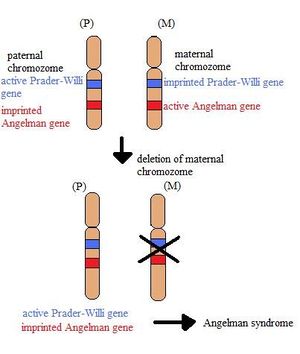Angelman Syndrome: Difference between revisions
From WikiLectures
m (inserted article) |
(grammar) |
||
| Line 1: | Line 1: | ||
<!---------------------------------------------------------------------------------------------------------------- | <!---------------------------------------------------------------------------------------------------------------- | ||
* INSERTED ARTICLE | * INSERTED ARTICLE | ||
* Warning – this article is used in other articles where is inserted. If you are changing this article, you are changing other articles at the same moment. Please, be careful when you are editing it: | * Warning – this article is used in other articles where it is inserted. If you are changing this article, you are changing other articles at the same moment. Please, be careful when you are editing it: | ||
* 1. Do not remove commands <noinclude> </noinclude>. These command usually mark which are not used in other articles, where is this article used. | * 1. Do not remove commands <noinclude> </noinclude>. These command usually mark which are not used in other articles, where is this article used. | ||
* 2. Do not change level of headings. | * 2. Do not change level of headings. | ||
| Line 13: | Line 13: | ||
__NOTOC__<noinclude>{{Dictionary | __NOTOC__<noinclude>{{Dictionary | ||
|eng=Angelman syndrome}}</noinclude> | |eng=Angelman syndrome}}</noinclude> | ||
[[File:Angelman.jpg|thumb|'' | [[File:Angelman.jpg|thumb|''Chromosome 15'' - '''Angelman syndrome''']] | ||
*This syndrome is caused by the | *This syndrome is caused by the loss of function of ''gene UBE3A'' - just the maternal copy of this gene is functional. Thus loss of the maternal gene causes this symptome. This genetic disorder is connected especially with the nervous system. Children are affected in their early age. | ||
*''Typical symptoms'': | *''Typical symptoms'': developmental delay, speech problems, ataxia, epilepsy or microcephaly. | ||
* | *Patients are sometimes called "'''happy puppets'''" because of their behavior. They frequent smile, laugh and have flapping movements. | ||
*Incidence of Angelman syndrome is ''1 in 12 000 - 20 000'' people worldwide. | *Incidence of Angelman syndrome is ''1 in 12 000 - 20 000'' people worldwide. | ||
<noinclude> | <noinclude> | ||
| Line 24: | Line 24: | ||
* [[Gene]] | * [[Gene]] | ||
* [[Allele]] | * [[Allele]] | ||
* [[ | * [[Chromosome]] | ||
=== Sources=== | === Sources=== | ||
* [http://ghr.nlm.nih.gov/handbook/inheritance/updimprinting What are Genomic Imprinting and Uniparental Disomy] | * [http://ghr.nlm.nih.gov/handbook/inheritance/updimprinting What are Genomic Imprinting and Uniparental Disomy] | ||
Revision as of 11:47, 7 August 2011
| English: Angelman syndrome |
- This syndrome is caused by the loss of function of gene UBE3A - just the maternal copy of this gene is functional. Thus loss of the maternal gene causes this symptome. This genetic disorder is connected especially with the nervous system. Children are affected in their early age.
- Typical symptoms: developmental delay, speech problems, ataxia, epilepsy or microcephaly.
- Patients are sometimes called "happy puppets" because of their behavior. They frequent smile, laugh and have flapping movements.
- Incidence of Angelman syndrome is 1 in 12 000 - 20 000 people worldwide.
Links
Related articles
Sources
Bibliography
- KUMAR, ABBAS, FAUSTO, MITCHELL,. Robbins Basic Pathology. 8th edition edition. 2007. ISBN 978-0-8089-2366-4.




